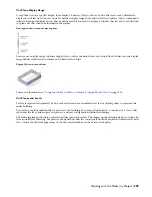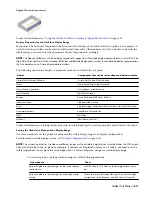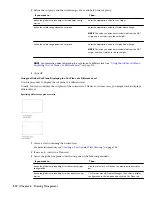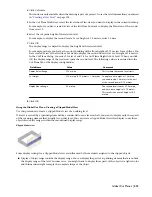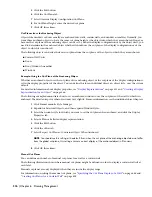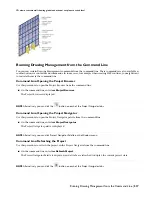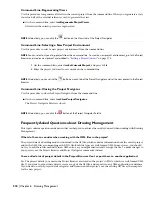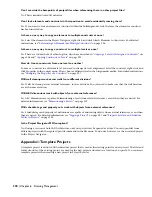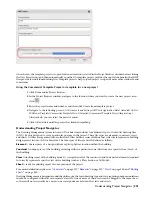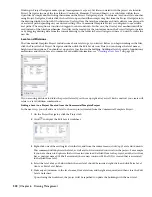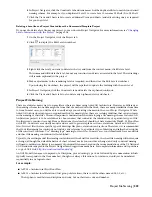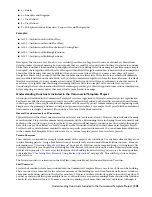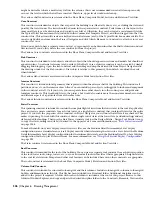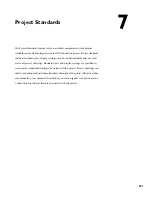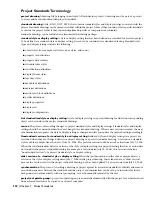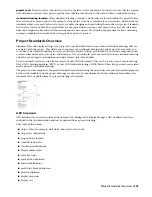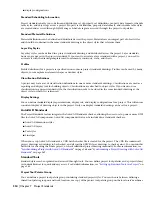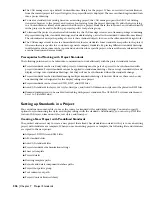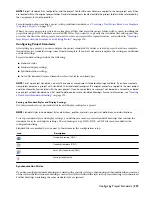
Working in Project Navigator makes project management very easy. All files associated with the project are listed in
Project Navigator in one of the four folders (Constructs, Elements, Views and Sheets), or a sub-folder within these.
Open files by simply double clicking their name on the Project Navigator palette. To reference (xref) one file to another
using Project Navigator, double click the host file to open it and then simply drag files from the Project Navigator into
the drawing window in AutoCAD Architecture. Xrefs will use the Attach mechanism and write either a complete path
or a relative path depending on your desired setting. (The Commercial Template Project is configured to use relative
xref paths.) The exception is constructs dragged to other constructs. In this case, the Overlay xref mechanism will be
used instead of the Attach mechanism. New files can be created via the context menu on the Project Navigator palette
or by dragging drawing data from the current drawing to the folder in Project Navigator where you wish to create the
new file.
Levels and Divisions
The Commercial Template Project includes some basic levels to get you started. Before you begin working in the files,
click the Project tab of Project Navigator and then click the Edit Levels icon. Here you can change the level names,
heights and descriptions. You should set up one level per floor in the building. Additional levels for grade, foundations,
mezzanines and the roof are also common. For detailed information, see “
Creating a New Level
” on page 205.
If you are using divisions to divide the project laterally, set those up right away as well. Each construct you create will
relate to a level/division combination.
Adding a Level to a Project Created from the Commercial Template Project
In the next step, you will add a new level to the new project created from the Commercial Template Project.
1
On the Project Navigator, click the Project tab.
2
Click
to display the Edit Levels worksheet.
3
Right-click one of the existing levels in the list, and from the context menu, click Copy Level and Contents.
This command will duplicate the level, as well as all of its associated constructs in the project. For example
if you have chosen to duplicate the first floor in order to add a third floor to the project, and the first floor
has a construct named 01 Shell associated, then a new construct 01 Shell (2) is created that is associated
to the third floor level.
4
Select the level above or below which the new level should be inserted, right-click, and click Paste Level
Above or Paste Level Below.
5
Make any adjustments to the level name, floor elevation, and height as required, and then close the Edit
Levels worksheet.
Upon closing the worksheet, the project will be repathed to update the building with the new level.
322 | Chapter 6 Drawing Management
Summary of Contents for 00128-051462-9310 - AUTOCAD 2008 COMM UPG FRM 2005 DVD
Page 1: ...AutoCAD Architecture 2008 User s Guide 2007 ...
Page 4: ...1 2 3 4 5 6 7 8 9 10 ...
Page 40: ...xl Contents ...
Page 41: ...Workflow and User Interface 1 1 ...
Page 42: ...2 Chapter 1 Workflow and User Interface ...
Page 146: ...106 Chapter 3 Content Browser ...
Page 164: ...124 Chapter 4 Creating and Saving Drawings ...
Page 370: ...330 Chapter 6 Drawing Management ...
Page 440: ...400 Chapter 8 Drawing Compare ...
Page 528: ...488 Chapter 10 Display System ...
Page 540: ...500 Chapter 11 Style Manager ...
Page 612: ...572 Chapter 13 Content Creation Guidelines ...
Page 613: ...Conceptual Design 2 573 ...
Page 614: ...574 Chapter 14 Conceptual Design ...
Page 678: ...638 Chapter 16 ObjectViewer ...
Page 683: ...Designing with Architectural Objects 3 643 ...
Page 684: ...644 Chapter 18 Designing with Architectural Objects ...
Page 788: ...748 Chapter 18 Walls ...
Page 942: ...902 Chapter 19 Curtain Walls ...
Page 1042: ...1002 Chapter 21 AEC Polygons ...
Page 1052: ...Changing a door width 1012 Chapter 22 Doors ...
Page 1106: ...Changing a window width 1066 Chapter 23 Windows ...
Page 1172: ...1132 Chapter 24 Openings ...
Page 1226: ...Using grips to change the flight width of a spiral stair run 1186 Chapter 25 Stairs ...
Page 1368: ...Using the Angle grip to edit slab slope 1328 Chapter 28 Slabs and Roof Slabs ...
Page 1491: ...Design Utilities 4 1451 ...
Page 1492: ...1452 Chapter 30 Design Utilities ...
Page 1536: ...1496 Chapter 31 Layout Curves and Grids ...
Page 1564: ...1524 Chapter 32 Grids ...
Page 1611: ...Documentation 5 1571 ...
Page 1612: ...1572 Chapter 36 Documentation ...
Page 1706: ...Stretching a surface opening Moving a surface opening 1666 Chapter 36 Spaces ...
Page 1710: ...Offsetting the edge of a window opening on a freeform space surface 1670 Chapter 36 Spaces ...
Page 1956: ...1916 Chapter 42 Fields ...
Page 2035: ...Properties of a detail callout The Properties of a Callout Tool 1995 ...
Page 2060: ...2020 Chapter 45 Callouts ...
Page 2170: ...2130 Chapter 47 AEC Content and DesignCenter ...
Page 2171: ...Other Utilities 6 2131 ...
Page 2172: ...2132 Chapter 48 Other Utilities ...
Page 2182: ...2142 Chapter 51 Reference AEC Objects ...
Page 2212: ...2172 Chapter 52 Customizing and Adding New Content for Detail Components ...
Page 2217: ...AutoCAD Architecture 2008 Menus 54 2177 ...
Page 2226: ...2186 Chapter 54 AutoCAD Architecture 2008 Menus ...
Page 2268: ...2228 Index ...


